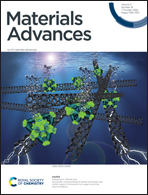Toxic metal–organic gels using a unique pyridine–pyrazole based ligand with Pb(ii), Cd(ii) and Hg(ii) salts: multi-stimuli responsiveness and toxic dye adsorption†
Abstract
The present work reports the design and synthesis of a low molecular weight gelator (LMWG), namely 1-(3-(pyridin-2-yl)-1H-pyrazole-5-carboylimino)ethyl)phenyl)ethylidene)-3-(pyridin-2-yl)-1H-pyrazole-5-carbohydrazide (H3BPDP). H3BPDP acts as a gelator to encapsulate the toxic heavy metal ions Pb(II), Cd(II) and Hg(II) and forms metal-organic gels (MOGs). Microscopic analyses such as SEM and TEM of the MOGs revealed intertwining fibrous networks for Cd and Hg, whereas interesting nanoscale metal-organic particles (NMOPs) were formed with Pb-MOG. After heating the Pb-MOG for a few hours and keeping the solution for slow evaporation for a few days, remarkably single crystals were grown. Single-crystal X-ray analysis indeed confirmed the encapsulation of Pb2+ by the gelator, H3BPDP, and a two-dimensional coordination polymer of composition [Pb5(BPDP)2(NO3)4(DMF)]n was observed. Moreover, EDAX analysis also confirmed the encapsulation of Pb, Cd, and Hg elements from their respective xerogels. The formation of MOGs with the toxic metals was also monitored by 1H NMR titration and ligand participation in the formation of the metal–N bond was clearly perceptible by monitoring the N–H proton. The MOGs exhibited sol–gel transformation by applying thermo-, chemical, pH- and mechano-stimuli. Besides that, the xerogels of the Cd-based MOG and Pb-based MOG have shown remarkable efficiency (>80%) to adsorb the toxic methyl orange (MO) dye, which may be utilized in wastewater treatment.



 Please wait while we load your content...
Please wait while we load your content...